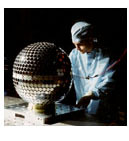

Michael A. Savell.
 
|
John Vasquez of the Naval Research
Laboratory prepares Starshine 1 for
vibration test. Photo by Michael A. Savell. |
|
Starshine 4/5 Update for March 7, 2002
|

|
We are rapidly approaching the end of the mirror grinding and polishing phase of the Starshine 4/5 mission.
Our friends at QSI Corporation in Salt Lake City, Utah, have shipped over 925 mirror polishing kits to
schools in 43 countries for this mission. For a newspaper story about their activities,
click here.
If you have already submitted a School Participation Request form, you should receive your kit by the middle of March. Each kit contains three mirrors. Please polish them all and send us your best two. Not all schools return their mirrors to us, if you can believe that, and some of the polished mirrors are of unusable quality, so we'll always be needing extras at the last minute. You may keep your third best for your school trophy case or other suitable location. |
|
The deadline for returning your polished mirrors to us is March 31, 2002. By the way, through an omission on the project director's part, self-addressed return envelopes for the student name sheets were not included in the kit. So, you'll have to supply and address your own envelopes to Mr. R. Gilbert Moore, Starshine 4/5, 3855 Sierra Vista Road, Monument, CO, 80132-8216. We're sorry for this inconvenience. We are no longer encouraging schools outside the U.S. to apply for kits for this mission, due to the extensive length of time it takes to ship the kits overseas and get them back. It’s now really too late for that all to take place before the March 31 deadline. Schools in the US may still apply for another week or so, and then we’ll have to shut down the application process. Those of you who have received your kits but haven’t polished your mirrors, please do so and mail them back to the project headquarters in Monument, Colorado, as soon as possible. In the middle of April, we’ll take your polished mirrors to the Space Optics Manufacturing Technology Center of NASA’s Marshall Space Flight Center in Huntsville, Alabama, for the application of a thin, clear, protective silicon dioxide coating. The coating’s actual thickness is 2700 Angstroms, which is one-half wavelength of the light you used to measure the flatness of your completed mirrors. This coating will protect the surface of your mirrors from becoming converted into aluminum oxide by reacting with atomic oxygen that exists at the altitudes at which the Starshine satelites orbit the earth. Aluminum is 10 per cent more reflective than aluminum oxide in visible light, and we need all the help we can get to make your tiny mirrors reflect enough sunlight to be seen up to 1000 miles away in the twilight sky. The other purpose of this coating is to protect the surfaces of your mirrors while we’re handling them in the mirror installation and satellite testing processes. NASA optical physicist Vince Huegele is shown displaying a rack of coated mirrors in the image at the upper left corner of this page. NASA has firmly manifested our Starshine 4/5 dual-satellite experiment on the STS-114 Shuttle mission to the International Space Station in January of 2003. Our mirror placement expert, Doug Winfield of Seneca, South Carolina, has improved the hole drilling pattern on this satellite, so we'll be able to mount 1000 mirrors and 31 laser retroreflectors on its external shell. Skip Dopp of the Bridgerland Applied Technology College in Logan, Utah, has obtained spun aluminum structural hemispheres for this satellite, and his team has started drilling mirror mounting holes in them. The team is also machining some of the spacecraft's internal structural components and retroreflector mounts, as well as the shell of the Starshine 5 subsatellite. We have recently changed our plans for the Starshine 4/5 mission. Instead of releasing an inflatable balloon from inside the Starshine 4 satellite, we're going to release a 4 inch (10 cm) hollow aluminum sphere, instead, which we’ll name Starshine 5. This small subsatellite will be released shortly after Starshine 4 is deployed from Space Shuttle Atlantis in January 2003. Both Starshines 4 and 5 will carry 31 laser retroreflectors on their surfaces and will be tracked by the International Satellite Laser Ranging Network (ISLR) and the U.S. Space Command. In addition, Starshine students will visually track the faint flashes of sunlight reflecting from 1000 polished mirrors mounted on the surface of Starshine 4. All these data will be combined to determine the orbit of Starshine 4. Starshine 5 will have no mirrors and will thus not be naked-eye visible, so we will depend totally on ISLR and Space Command tracking for orbit determination of this satellite. By comparing the orbital decay rates of Starshines 4 and 5, it will possible for us to determine the density of the earth’s atmosphere more precisely than we’ve been able to do on previous missions.
|
Return to Project Starshine Home Page
Last Updated: March 9, 2002